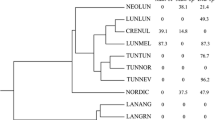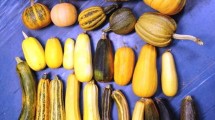Abstract
Allozymic variation at 30 isozyme loci was examined electrophoretically in nine annual and one perennial species ofCicer. While most of the accessions examined were monomorphic, species can be differentiated on the basis of their enzyme phenotypes. Several groups of species were identified based upon genetic distance values. For example,C. arietinum, C. reticulatum, andC. echinospermum shared the same alleles for most of the loci exmained. PerennialC. anatolicum is also closely related to this group. Similarly,C. judaicum, C. bijugum, andC. pinnatifidum formed another group. Two annual species,C. chorassanicum andC. yamashitae clustered together, whereasC. cuneatum was the most distantly related species. Correlations were found between genetic distances and geographic distribution. Results from enzyme electrophoresis tend to support the previously reported taxonomic treatments based upon crossability and morphological similarity. However,C. yamashitae, which has been classified in the second crossability group, is quite distinct genetically and morphologically from the remaining species of the group. An isozyme gene duplication observed in the genus suggested the monophyletic origin of the species examined in the present study.
Similar content being viewed by others
References
Ahmad, F., 1989: The chromosomal architecture ofCicer anatolicum Alef., a wild perennial relative of chickpea. — Cytologia54: 753–757.
, 1988: Investigations into barrier(s) to interspecific hybridization betweenCicer arietinum L. and eight other annualCicer species. — Pl. Breed.100: 14–18.
Cardy, B. J., Beversdorf, W. D., 1984: A procedure for the starch gel elecrophoretic detection of isozymes of soybean (Glycine max [L.].Merr.). — Tech. Bull. No. 119/8401, Dept. of Crop Sci., Univ. of Guelph, Ontario.
-Stuber, C. W., Goodman, M. M., 1980: Techniques for starch gel electrophoresis of enzymes from maize (Zea mays L.). — Raleigh NC, NCSU Dept. Stat. Mimeo Series No.1317.
Clayton, J. W., Tretiak, D. N., 1972: Amine-citrate buffers for pH control in starch gel electrophoresis. — J. Fish Res. Bd. Canad.29: 1169–1172.
Gottlieb, L. D., 1982: Conservation and duplication of isozymes in plants. — Science216: 373–380.
, 1976: Genetic similarity betweenGuara longiflora and its obligately outcrossing derivativeG. demareei. — Syst. Bot.1: 181–187.
Hamrick, J. L., 1983: The distribution of genetic variation within and among natural plant populations. — InSchonewald, L. M., Chambers, S. M., Mucbig, B., andThomas, L. (Eds.): Genetics and conservation, pp. 335–348. — MontePark, Cal.: Benjamin-Cummings.
Kabir, G., Singh, R. M., 1988: Seed protein electrophoresis in six species and two F 1 s ofCicer. — Proc. Indian Acad. Sci. (Plant Sci.)98: 183–189.
Kupicha, F. K., 1977: The delimitation of the tribeVicieae Alef. and the relationship ofCicer L. — Bot. J. Linn. Soc.74: 131–162.
Ladizinsky, G., 1975: A newCicer from Turkey. — Notes Bot. Gard. Edinburgh34: 201–202.
, 1975: The origin of chickpea as indicated by seed protein electrophoresis. — Israel J. Bot.24: 183–189.
, 1976a: The origin of chickpea,Cicer arietinum L. — Euphytica25: 211–217.
, 1976b: Genetic relationships among annual species ofCicer L. — Theor. Appl. Genet.48: 197–203.
, 1988: Exploitation of wild relatives of the food legumes. — InSummerfield, R. J., (Ed.): World crops: cool season food legumes, pp. 967–978. — Dordrecht, The Netherlands: Kluwer Academic Publishers.
van der Maesen, L. J. G., 1987: Origin, history and taxonomy of chickpea. — InSaxena, M. J., Singh, K. B. (Eds.): The Chickpea, pp. 11–34. — Cambridge: CAB International.
Moreno, M.-T., Cubero, J. I., 1978: Variation inCicer arietinum L. — Euphytica28: 465–477.
Muehlbauer, F. J., Weeden, N. F., Hoffman, D. L., 1989: Inheritance and linkage relationships of morphological and isozyme loci in lentil (Lens Miller). — J. Hered.80: 298–303.
Nei, M., 1972: Genetic distance between populations. — Amer. Naturalist106: 283–292.
, 1978: Estimation of average heterozygosity and genetic distance from a small number of individuals. — Genetics89: 583–590.
, 1974: Sampling variances of heterozygosity and genetic distance. — Genetics76: 379–390.
Nozzolillo, C., 1985: Seedling morphology and anatomy of eightCicer species and their taxonomic value. — Canad. J. Bot.63: 1–6.
Oram, R. N., Shaikh, M. A. Q., Zaman, K. M. S., Brown, A. H. D., 1987: Isozyme similarity and genetic differences in morphology between Hyprosola, a high yielding, high protein mutant of chickpea (Cicer arietinum L.) and its parental cultivar. — Envir. Exper. Bot.27: 455–462.
Selander, R. K., Smith, M. H., Yang, S. Y., Johnson, W. E., Gentry, J. B., 1971: Biochemical polymorphism and systematics in the genusPeromyscus. I. Variation in the old-field mouse (Peromyscus polionotus). — Univ. Texas Publ.7103: 49–90.
Soltis, D. E., Haufler, C. H., Darrow, D. C., Gastony, G. J., 1983: Starch gel electrophoresis of ferns: a compilation of grinding buffers, gel and electrode buffers, and staining schedules. — Amer. Fern. J.73: 9–27.
Swofford, D. L., Selander, R. B., 1981: BIOYS-1: a FORTRAN program for the comprehensive analysis of electrophoretic data in population genetics and systematics. — J. Heredity72: 281–283.
Tuwafe, S., Kahler, A. L., Boe, A., Ferguson, M., 1988: Inheritance and geographical distribution of allozyme polymorphisms in chickpea (Cicer arietinum L.). — J. Heredity79: 170–174.
Vallejos, E., 1983: Enzyme activity staining. — InTanksley, S. D., Orton, T. J., (Eds.): Isozymes in plant genetics and breeding, A, pp. 469–516. — Amsterdam: Elsevier.
Weeden, N. F., Gottlieb, L. D., 1980: Isolation of cytoplasmic enzymes from pollen. — Pl. Physiol.66: 400–403.
, 1988: Applications of isozyme analysis in pulse crops. — InSummerfield, R. J., (Ed.): World crops: cool season food legumes, pp. 979–987. — Dordrecht, The Netherlands: Kluwer Academic Publishers.
Author information
Authors and Affiliations
Rights and permissions
About this article
Cite this article
Kazan, K., Muehlbauer, F.J. Allozyme variation and phylogeny in annual species ofCicer (Leguminosae). Pl Syst Evol 175, 11–21 (1991). https://doi.org/10.1007/BF00942142
Received:
Accepted:
Issue Date:
DOI: https://doi.org/10.1007/BF00942142




